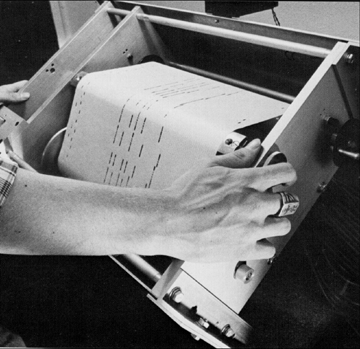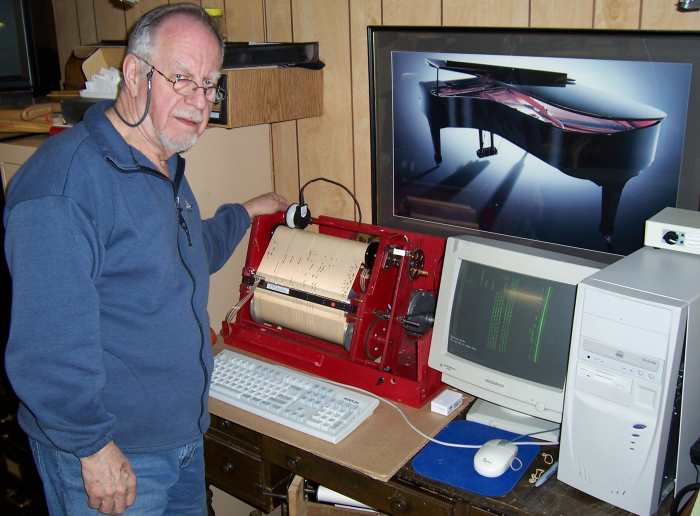Music File Formats
How
Digital Audio files differ from MIDI files
MIDI file
formats
Piano E-Rolls
Two
different kinds of music files used in MIDI Players are digital audio
files and MIDI files. They are both data files with tables of numbers. The digital audio files are found on CDs with
singing and orchestra accompaniments. The MIDI files contain the data that make
the keys on the piano play and control the sounds on the tone
generators. Music CDs purchased for MIDI Players contain the digital audio
on one channel, and the MIDI information on the other channel. These CDs
can be copied for back-up purposes, but the
information written on them cannot be accessed for editing. Most of this
website is devoted to using and editing MIDI and digital audio files before they
are placed on CDs as .cda files.
How Digital Audio Files differ from MIDI files
An audio file (.wav or .mp3) contains a massive amount of numbers that represent the fluctuating amplitude of the pressure wave in front of the microphone that made the recording. No matter if the sound was an orchestra, a guitar or a car horn, the audio file simply contains measurements for the pattern of motion produced by that sound. When you hear an orchestra playing on an audio CD, the strings, brass, woodwinds, and vocalists are all playing on a single track. Each instrument or group may have originally been recorded on their own track with their own microphone, but then "mixed down" to create the single track written to the CD. An audio CD is basically packaged music that the "user" can enjoy, but not interact with. A one minute .wav file takes up almost 9 MB. A one minute .mp3 file takes up 400-800 MB depending upon the density of the encoding.
MIDI based music data (.mid) files can be controlled by the user. The orchestra sounds you hear in a MIDI file tone generator are sampled sounds, not live performances. Each instrument or voice is assigned to its own track. The data in a MIDI file tells what note to play, how long to play it, how loud, at what pitch, using what instrument, etc. MIDI files are much more flexible than digital audio files, as you can reassign instruments, change tempo, change the volume, add or delete some notes, etc. by using a music editing program called a Sequencer. Sheet music is also arranged and printed from MIDI files using Notation Software. Detailed descriptions of different kinds of music software appear in the Music Software section of this website. MIDI data of live piano performances can be transmitted in real time over the internet to be received by another MIDI Player Piano far away while you view images of this live performance on television! MIDI files are also very small. About 1 minute of MIDI data fits into a10-20 kb data file.
Musical Instrument Digital Interface (MIDI) is a communications standard that allows musical instruments and related devices from any manufacturer to communicate with one another via a simple cable. It is like a word processor for music.
MIDI Players use 16 Channels in MIDI with
128 track
assignments. Refer to the
MIDI
Voice Chart
![]() to see the 128 standard MIDI voices and program assignments.
Volume, and other MIDI data are given values from 0 to 128. One or several
voices (tracks) can be assigned to a single channel. The data in the MIDI
file that plays the keys on your Midi Player Piano is found on Channels 1 and 2
- sometimes referred to as L and R. For a Disklavier, the half pedal data is found on Channel 3, and the
Drums are found on Channel 10. Pedal data is also displayed while the file is
playing on a Disklavier. If the play time is displayed in brackets,
<00.00> the pedal is either On or Off. It the play time is displayed in
parentheses, (00:00) the pedal was recorded incrementally.
to see the 128 standard MIDI voices and program assignments.
Volume, and other MIDI data are given values from 0 to 128. One or several
voices (tracks) can be assigned to a single channel. The data in the MIDI
file that plays the keys on your Midi Player Piano is found on Channels 1 and 2
- sometimes referred to as L and R. For a Disklavier, the half pedal data is found on Channel 3, and the
Drums are found on Channel 10. Pedal data is also displayed while the file is
playing on a Disklavier. If the play time is displayed in brackets,
<00.00> the pedal is either On or Off. It the play time is displayed in
parentheses, (00:00) the pedal was recorded incrementally.
It is
important to know which MIDI file formats play on your piano. Refer to the
Chart: Disk and File
Formats
![]() to determine which MIDI formats your MIDI player piano
uses.
to determine which MIDI formats your MIDI player piano
uses.
Standard MIDI Format 0 (SMF-0) - This format assembles all MIDI data on a single track, allowing playback on even the simplest of sequencers or playback devices. This format also offers the greatest compatibility.
Standard MIDI Format 1 (SMF-1) - Format 1 is capable of handling multiple tracks, and is designed to work best with sequencers that allow different parts to be recorded and played back on different tracks - essential for editing and modifying data as well as simple playback
ESEQ is a Yamaha proprietary MIDI format for Disklaviers and usually have the extension .FIL. This is the only file format that can be played on the MX100A/B, Wagon Grand, DGP and MX80 Disklaviers from the floppy disk drive. All MIDI Player pianos, including all models of Disklaviers, can play standard MIDI files in format 0 from a computer (running Sequencer or Jukebox software) attached via a MIDI interface.
Yamaha refers to MIDI files as Import Files in their Owner’s Manuals and prompts on the Control Box messages. Software utilities are used to convert one MIDI file format to another and is described in greater detail in the Music Software section of this website.

 Right - Terry Smythe and his roll scanner
Right - Terry Smythe and his roll scanner
Owners of MIDI Players owe a GREAT deal to those who have labored long and lovingly to preserve the music found on the old paper rolls used in mechanical player pianos. They designed and built "scanners" and converted thousands of paper rolls to MIDI files. Richard Stibbons in the U.K. and Wayne Stahnke were engineers who started the process. Mark Fontana wrote his master's thesis on preserving the Pianocorder Library. Warren Trachtman (www.trachtman.org) has done much to develop scanners and preserve Ragtime. Spencer Chase is a prolific producer of e-rolls (www.spencerserolls.com). And Terry Smythe in Canada has made available to us over 6,000 free MIDI files from piano roll scans at http://members.shaw.ca/Smythe/archive.htm. The following documents give a better explanation than I can about how our beloved MIDI libraries were created:
Preservation and MIDI Translation of the
Pianocorder Music Library (1997)
![]() by Mark
Fontana
by Mark
Fontana
What is an E-Roll?
![]() by Walter
Tenten and Warren Trachtman
by Walter
Tenten and Warren Trachtman
Converting Piano
Rolls to MIDI
![]() by Warren
Trachtman
by Warren
Trachtman